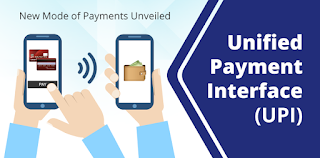India is inching towards a cashless economy through innovative payment solutions introduced by the RBI and the National Payment Corporation of India (NPCI). Their latest offering is the Unified Payment Interface (UPI), using which your smartphones get transformed into virtual debit cards for money transfer.
 |
| Image Source: http://www.infrasofttech.com/ |
The UPI Demystified
- The UPI interface allows customers to make fund transfers between two people, person-to-business and business-to-person.
- In the current mobile payment system, only the ‘send’ mode is available. The advantage of the UPI is that it enables the person receiving the funds to initiate a transaction. So, in addition to the ability to send funds to a recipient, the UPI empowers the recipient to initiate a cash ‘collection’ from a source.
- Previously users need to to provide their account number, branch IFSC code, Aadhaar number, mobile number. Although the platform also use the Aadhaar number, mobile number and account number of an individual, these details are not divulged during the payment process.
- The user could initiate transfers using virtual addresses (resembling email ids) that are aliases to bank accounts. Alternatively, fund transfer is also possible using Aadhaar number as an identifier. This is a very useful functionality for the rural demographic.
- An exciting feature of the interface is the ‘pay by’ date, which allows payment requests to be put on hold and paid at a later date. It allows recurring payments, like salaries, school fees, subscriptions, etc. with a one-time secure authentication.
- It also allows PSPs to pay from an account using multiple virtual addresses, segregated by passwords, PINs or biometrics.
- Interoperability is the real game changer here. With the ambitious plans chalked out for the UPI system, the need to have different wallets for different e-commerce sites could be completely eliminated.
- The UPI platform mandates a limit of Rs. 1 lakh per transaction.
- UPI runs on IMPS; hence the service is available real-time and 24x7.
- NCPI has stated that each transaction through UPI will be charged Rs. 0.50, and it will appear as an IMPS transaction on the bank statement.
- UPI is an extremely secure payment method, and transactions happen in an encrypted format.
- Currently, the UPI app is not available on App Stores, but it will be launched shortly.
Impact on Mobile Wallets:
Popular mobile wallets like MobiKwik has millions of users who are loyal to these platforms owing to the convenience, security and speed of transactions. With the UPI in place, these companies expect to unlock new channels for growth and enlarge their reach.
The RBI has only authorised banks to be Payment Service Providers for UPI, keeping mobile wallets away from the platform. These non-bank members are currently awaiting directions from the RBI and NCPI to get access to the system. Unless wallet companies signify their relevance through innovative methods, they will find it difficult to survive the competition.
Impact on Payment Gateways:
Payment gateways aggregate various payment methods like credit cards, netbanking and mobile wallets. These also offer detailed information on received payments, provide transaction management insights and enable customisation at every level. This is beyond the current capabilities of the UPI. Moreover, the protection that payment gateways offer against disputes is unavailable in the UPI today, but will be incorporated as the platform matures.
In conclusion, the success of the UPI largely depends on smartphone penetration in the country. But it currently looks like a step in the right direction towards faster, smoother and easier payments.